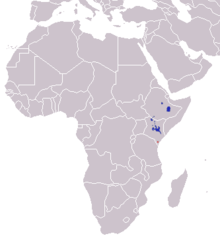Grevy's Zebra
| Grévy's zebra | |
|---|---|
 |
|
| A Grévy's zebra at Buffalo Springs National Reserve. | |
| Scientific classification | |
| Kingdom: | Animalia |
| Phylum: | Chordata |
| Class: | Mammalia |
| Order: | Perissodactyla |
| Family: | Equidae |
| Genus: | Equus |
| Species: | E. grevyi |
| Binomial name | |
|
Equus grevyi Oustalet, 1882 |
|
 |
|
| Grévy's zebra range (blue — native, red — introduced) |
|
The Grévy's zebra (Equus grevyi), also known as the imperial zebra, is the largest extant wild equid and the largest and most threatened of the three species of zebra, the other two being the plains zebra and the mountain zebra. Named after Jules Grévy, it is the sole extant member of the subgenus Dolichohippus. The Grévy's zebra is found in Kenya and Ethiopia. Compared with other zebras, it is tall, has large ears, and its stripes are narrower.
The Grévy's zebra lives in semi-arid grasslands where it feeds on grasses, legumes, and browse; it can survive up to five days without water. It differs from the other zebra species in that it does not live in harems and has few long-lasting social bonds. Male territoriality and mother–foal relationships form the basis of the social system of the Grévy's zebra. This zebra is considered to be endangered. Its population has declined from 15,000 to 3,000 since the 1970s. However, as of 2008, the population is stable.
The Grévy's zebra was first described by French naturalist Émile Oustalet in 1882. He named it after Jules Grévy, then president of France, who, in the 1880s, was given one by the government of Abyssinia. Traditionally, this species was classified in the subgenus Dolichohippus with plains zebra and mountain zebra in Hippotigris. Fossils of zebra-like equids have been found throughout Africa and Asia in the Pliocene and deposits. Notable examples include E. sanmeniensis from China, E. cautleyi from India, E. valeriani from central Asia and E. oldowayensis from East Africa. The latter, in particular is very similar to the Grévy's zebra and may have been its ancestor. The modern Grévy's zebra arose in the early Pleistocene. Zebras appear to be a monophyletic lineage and recent (2013) phylogenies have placed Grevy's zebra in a sister taxon with the plains zebra. In areas where Grévy's zebras are sympatric with plains zebras, the two may gather in same herds and fertile hybrids do occur.
...
Wikipedia

